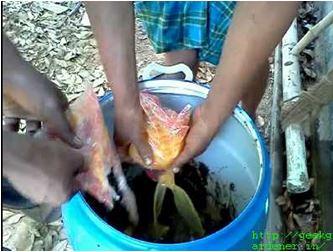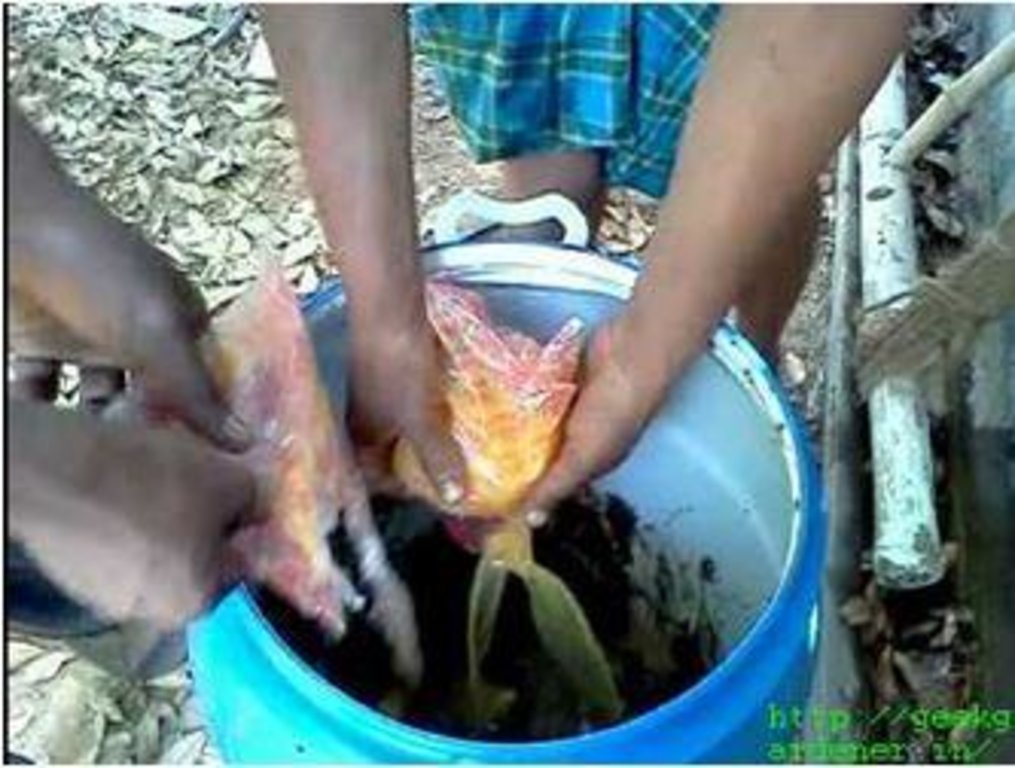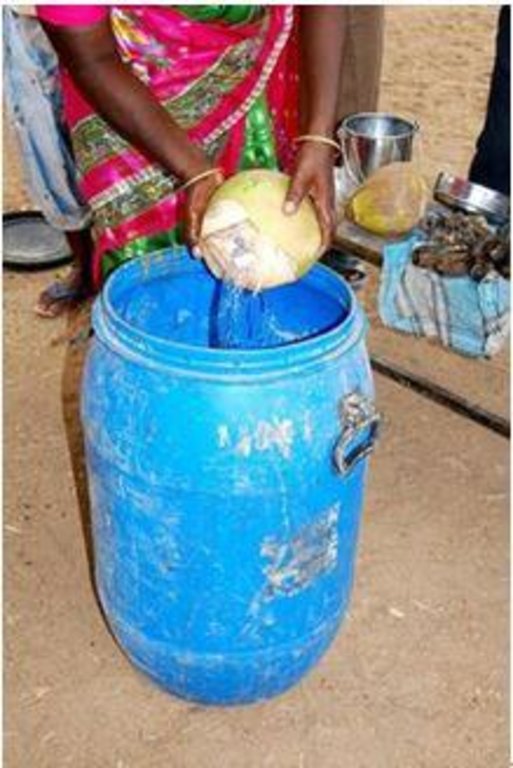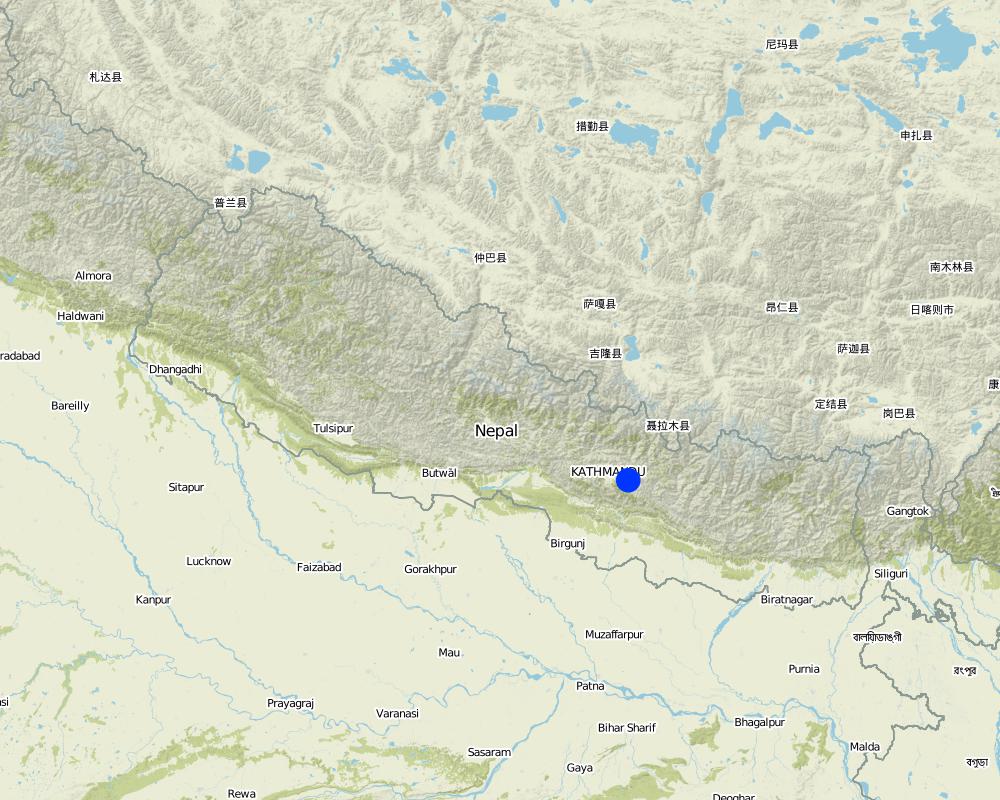Use of Panchhagavya for Plant Protection [Nepal]
- Creation:
- Update:
- Compiler: Sabita Aryal
- Editor: –
- Reviewers: David Streiff, Alexandra Gavilano
Panchhagavya
technologies_1145 - Nepal
View sections
Expand all Collapse all1. General information
1.2 Contact details of resource persons and institutions involved in the assessment and documentation of the Technology
Key resource person(s)
SLM specialist:
SLM specialist:
Maskey Sunwi
Kathmandu University
Nepal
SLM specialist:
K.C Rabi
Kathmandu University
Nepal
SLM specialist:
Shrestha Archana
Kathmandu University
Nepal
SLM specialist:
Dahal Sabitri
SADP
Nepal
1.3 Conditions regarding the use of data documented through WOCAT
The compiler and key resource person(s) accept the conditions regarding the use of data documented through WOCAT:
Yes
2. Description of the SLM Technology
2.1 Short description of the Technology
Definition of the Technology:
Making the use of cow dung, cow urine, cow ghee, cow milk and honey with other materials, in order to make a fertilizer for plant production.
2.2 Detailed description of the Technology
Description:
Panchhagavya was in practice from Neolithic period but recently has become a common interest. It has been used by Hindu Society and has also been mentioned in Vedas. In 1950, James F. Martin made a liquid by lactating cow milk, using dung, sea water and yeast. It was claimed that it was capable of greening degrading land.
It is an organic product that has the potential to play the role of promoting growth and providing immunity in plant system. It consists of nine products i.e. cow dung, cow urine, milk, curd, jaggery, ghee, ripened banana, tender coconut and water.
This technology most importantly focuses on agronomic measures and conserves the manuring and composting. It does not lead to changes in slope profile of the land. Organic matter is used for soil surface treatment which increases the fertility of the soil. This agronomic measure is also combined with management measures where change in management of soil results in giving improved vegetable cover.
Purpose of the Technology: The main purpose of Panchhagavya is to deal with major land problems such as soil infertility, less production of crops and water pollution due to use of fertilizers. It focuses on cropland where annual cropping is done. Annual crops are usually harvested within one or maximally within two years. Chemical and physical soil deterioration and biological degradation are the types of land degradation addresses by the technology.
Establishment / maintenance activities and inputs: In a container, mix 5kg of cow dung and 1/2kg of ghee. This mixture is stored in a shade for 4 days.On 5th day, the mixture is poured in a new container and cow milk, curd and cow urine is added to it. Then Jaggery is added by dissolving it in water. Ripened bananas are mashed and added to the above mixture with coconut water. This is stored for 30 days. Now, the mixture is stirred and mixed daily. This mixture is then sprayed to the crops. If the mixture is sprayed with hand sprayer then the nozzel must have greater pores. The preparation of Panchhagavya requires lot of products and takes around 30 days which makes it a bit costly.
Natural / human environment: The Panchhagavya thus produced is then sprayed in the agriculture fields. So, this can be used as a substitute for fertilizers as a type of organic manure. It can help promote greenery. Panchhagavya is prepared indoors in huge quantities and may be used overtime as required.
2.3 Photos of the Technology
2.5 Country/ region/ locations where the Technology has been applied and which are covered by this assessment
Country:
Nepal
Specify the spread of the Technology:
- evenly spread over an area
If precise area is not known, indicate approximate area covered:
- > 10,000 km2
Comments:
The use of Panchhagavya is specially seen in different sates of India and Nepal. The area isn't uniformly distributed.
Map
×2.6 Date of implementation
If precise year is not known, indicate approximate date:
- 10-50 years ago
2.7 Introduction of the Technology
Specify how the Technology was introduced:
- during experiments/ research
Comments (type of project, etc.):
It was in practice from neolithic period (7500-6500) but recently has become a common interest.
3. Classification of the SLM Technology
3.1 Main purpose(s) of the Technology
- Improve soil fertility
3.2 Current land use type(s) where the Technology is applied
Land use mixed within the same land unit:
Yes
Specify mixed land use (crops/ grazing/ trees):
- Agro-silvopastoralism

Cropland
- Annual cropping
- Perennial (non-woody) cropping
- Tree and shrub cropping
Annual cropping - Specify crops:
- root/tuber crops - potatoes
- rice
Tree and shrub cropping - Specify crops:
- citrus
Number of growing seasons per year:
- 2
Specify:
Longest growing period in days: 180; Longest growing period from month to month: July-December; Second longest growing period in days: 120; Second longest growing period from month to month: February-March

Grazing land
Extensive grazing:
- Nomadism
- Semi-nomadic pastoralism
- Ranching
Intensive grazing/ fodder production:
- Cut-and-carry/ zero grazing
- Improved pastures
- cows

Forest/ woodlands
- (Semi-)natural forests/ woodlands
- Tree plantation, afforestation
(Semi-)natural forests/ woodlands: Specify management type:
- Selective felling
- Clear felling
Products and services:
- Timber
- Fuelwood
- Fruits and nuts
- Other forest products
- Grazing/ browsing
- Nature conservation/ protection
- Recreation/ tourism
- Protection against natural hazards
Comments:
Main crops (cash and food crops): (CA) Rice, (CP) potato and (CT) orange
Major land use problems (compiler’s opinion): Soil infertility, less yield or production of crops, water pollution due to use of fertilizers.
Major land use problems (land users’ perception): Less yield of crops
Nomadism: Yes
Semi-nomadism / pastoralism: Yes
Ranching: Yes
Cut-and-carry/ zero grazing: Yes
Improved pasture: Yes
Selective felling of (semi-) natural forests: Yes
Clear felling of (semi-)natural forests: Yes
Plantation forestry: Yes
Forest products and services: timber, fuelwood, fruits and nuts, grazing / browsing, other forest products / uses (honey, medical, etc.), nature conservation / protection, recreation / tourism, protection against natural hazards
Future (final) land use (after implementation of SLM Technology): Cropland: Ca: Annual cropping
Constraints of mines and extractive industries
Constraints of settlement / urban
Constraints of infrastructure network (roads, railways, pipe lines, power lines)
Constraints of wastelands / deserts / glaciers / swamps
Livestock density: 1-10 LU /km2
3.3 Has land use changed due to the implementation of the Technology?
Has land use changed due to the implementation of the Technology?
- Yes (Please fill out the questions below with regard to the land use before implementation of the Technology)

Cropland
- Annual cropping
3.4 Water supply
Water supply for the land on which the Technology is applied:
- rainfed
Comments:
Water supply: Also mixed rainfed - irrigated, full irrigation and post-flooding
3.5 SLM group to which the Technology belongs
- integrated soil fertility management
3.6 SLM measures comprising the Technology

agronomic measures
- A2: Organic matter/ soil fertility
- A3: Soil surface treatment

vegetative measures
- V3: Clearing of vegetation

management measures
- M7: Others
Comments:
Main measures: agronomic measures
Secondary measures: vegetative measures, structural measures, management measures
Specification of other management measures: improves water holding capacity of soil
Type of agronomic measures: better crop cover, green manure, manure / compost / residues, soil conditioners (lime, gypsum)
3.7 Main types of land degradation addressed by the Technology

chemical soil deterioration
- Cn: fertility decline and reduced organic matter content (not caused by erosion)
- Cp: soil pollution
- Cs: salinization/ alkalinization

physical soil deterioration
- Ps: subsidence of organic soils, settling of soil
- Pu: loss of bio-productive function due to other activities

biological degradation
- Bc: reduction of vegetation cover
- Bq: quantity/ biomass decline
Comments:
Main type of degradation addressed: Cn: fertility decline and reduced organic matter content, Cp: soil pollution, Cs: salinisation / alkalinisation, Bc: reduction of vegetation cover, Bq: quantity / biomass decline
Secondary types of degradation addressed: Ps: subsidence of organic soils, settling of soil, Pu: loss of bio-productive function due to other activities
3.8 Prevention, reduction, or restoration of land degradation
Specify the goal of the Technology with regard to land degradation:
- prevent land degradation
- reduce land degradation
Comments:
Secondary goals: rehabilitation / reclamation of denuded land
4. Technical specifications, implementation activities, inputs, and costs
4.1 Technical drawing of the Technology
Technical specifications (related to technical drawing):
Panchagavya, an organic product has the potential to play the role of promoting growth and providing immunity in plant system. Panchagavya consists of nine products viz. cow dung, cow urine, milk, curd, jaggery, ghee, banana, Tender coconut and water.
Location: Bakhundol. Kathmandu
Date: 18-01-2014
Technical knowledge required for field staff / advisors: moderate
Technical knowledge required for land users: low
Main technical functions: increase in organic matter, increase in nutrient availability (supply, recycling,…), sediment retention / trapping, sediment harvesting, increase of biomass (quantity), promotion of vegetation species and varieties (quality, eg palatable fodder), spatial arrangement and diversification of land use
Secondary technical functions: control of raindrop splash, control of dispersed runoff: retain / trap, control of dispersed runoff: impede / retard, control of concentrated runoff: retain / trap, control of concentrated runoff: impede / retard, control of concentrated runoff: drain / divert, reduction of slope angle, reduction of slope length, improvement of ground cover, increase of surface roughness, improvement of surface structure (crusting, sealing), improvement of topsoil structure (compaction), improvement of subsoil structure (hardpan), stabilisation of soil (eg by tree roots against land slides), increase of infiltration, increase / maintain water stored in soil, increase of groundwater level / recharge of groundwater, water harvesting / increase water supply, water spreading, improvement of water quality, buffering / filtering water, reduction in wind speed, control of fires, reduction of dry material (fuel for wildfires)
Structural measure: soil management
Structural measure: increase crop yield
Structural measure: increase crops immunity
Other type of management: storage of the mixture should managed
Author:
Saurav Lohala
4.3 Establishment activities
| Activity | Timing (season) | |
|---|---|---|
| 1. | mix 7 kg cow dung and 1 kg cow ghee | store in shade for 4 days |
| 2. | on 5th day pour milk, curd and cow urine | 1 day |
| 3. | dissolve jaggery in water, add ripened banana and tender coconut water | store for 30 days |
| 4. | stir and mix mixture daily | for 30 days |
4.5 Maintenance/ recurrent activities
| Activity | Timing/ frequency | |
|---|---|---|
| 1. | Mix 5 kg of cow dung and 1/2 kg of ghee | 4 days |
| 2. | On 5th day pour milk, curd and cow urine | 5th day |
| 3. | Dissolve jaggery in water and add ripened banana and tender coconut water | 30 days |
| 4. | Stir and mix mixture daily | Everyday |
4.7 Most important factors affecting the costs
Describe the most determinate factors affecting the costs:
Fertilizers are found everywhere and is cheap but the properties of Panchhagavya requires a lot of products and takes around 30 days which makes it costly.
5. Natural and human environment
5.1 Climate
Annual rainfall
- < 250 mm
- 251-500 mm
- 501-750 mm
- 751-1,000 mm
- 1,001-1,500 mm
- 1,501-2,000 mm
- 2,001-3,000 mm
- 3,001-4,000 mm
- > 4,000 mm
Agro-climatic zone
- humid
- sub-humid
- semi-arid
- arid
Thermal climate class: tropics
Thermal climate class: subtropics
Thermal climate class: temperate
Thermal climate class: boreal
Thermal climate class: polar/arctic
5.2 Topography
Slopes on average:
- flat (0-2%)
- gentle (3-5%)
- moderate (6-10%)
- rolling (11-15%)
- hilly (16-30%)
- steep (31-60%)
- very steep (>60%)
Landforms:
- plateau/plains
- ridges
- mountain slopes
- hill slopes
- footslopes
- valley floors
Altitudinal zone:
- 0-100 m a.s.l.
- 101-500 m a.s.l.
- 501-1,000 m a.s.l.
- 1,001-1,500 m a.s.l.
- 1,501-2,000 m a.s.l.
- 2,001-2,500 m a.s.l.
- 2,501-3,000 m a.s.l.
- 3,001-4,000 m a.s.l.
- > 4,000 m a.s.l.
5.3 Soils
Soil depth on average:
- very shallow (0-20 cm)
- shallow (21-50 cm)
- moderately deep (51-80 cm)
- deep (81-120 cm)
- very deep (> 120 cm)
Soil texture (topsoil):
- medium (loamy, silty)
Topsoil organic matter:
- high (>3%)
If available, attach full soil description or specify the available information, e.g. soil type, soil PH/ acidity, Cation Exchange Capacity, nitrogen, salinity etc.
Soil fertility is very low - medium
Soil drainage / infiltration is medium
Soil water storage capacity is high
5.4 Water availability and quality
Ground water table:
5-50 m
Availability of surface water:
good
Water quality (untreated):
poor drinking water (treatment required)
5.5 Biodiversity
Species diversity:
- low
Comments and further specifications on biodiversity:
Species diversity: Also medium
5.6 Characteristics of land users applying the Technology
Market orientation of production system:
- subsistence (self-supply)
Off-farm income:
- 10-50% of all income
Relative level of wealth:
- very poor
- poor
Individuals or groups:
- individual/ household
Level of mechanization:
- manual work
- animal traction
Gender:
- women
- men
Indicate other relevant characteristics of the land users:
Land users applying the Technology are mainly common / average land users
Population density: > 500 persons/km2
Annual population growth: 2% - 3%
5.7 Average area of land used by land users applying the Technology
- < 0.5 ha
- 0.5-1 ha
- 1-2 ha
- 2-5 ha
- 5-15 ha
- 15-50 ha
- 50-100 ha
- 100-500 ha
- 500-1,000 ha
- 1,000-10,000 ha
- > 10,000 ha
Is this considered small-, medium- or large-scale (referring to local context)?
- small-scale
Comments:
Average area of land owned or leased by land users applying the Technology: Also 5-15 ha and 15-50 ha for use of wood.
5.8 Land ownership, land use rights, and water use rights
Land ownership:
- company
- communal/ village
Comments:
Land ownership: Also group
5.9 Access to services and infrastructure
health:
- poor
- moderate
- good
education:
- poor
- moderate
- good
technical assistance:
- poor
- moderate
- good
employment (e.g. off-farm):
- poor
- moderate
- good
markets:
- poor
- moderate
- good
energy:
- poor
- moderate
- good
roads and transport:
- poor
- moderate
- good
drinking water and sanitation:
- poor
- moderate
- good
financial services:
- poor
- moderate
- good
6. Impacts and concluding statements
6.1 On-site impacts the Technology has shown
Socio-economic impacts
Production
crop production
fodder production
fodder quality
wood production
risk of production failure
product diversity
land management
Water availability and quality
irrigation water availability
irrigation water quality
demand for irrigation water
Income and costs
farm income
economic disparities
workload
Socio-cultural impacts
food security/ self-sufficiency
health situation
cultural opportunities
community institutions
national institutions
SLM/ land degradation knowledge
conflict mitigation
livelihoods and human well-being
Ecological impacts
Water cycle/ runoff
harvesting/ collection of water
surface runoff
excess water drainage
evaporation
Soil
soil moisture
soil cover
soil loss
soil crusting/ sealing
soil compaction
nutrient cycling/ recharge
salinity
Biodiversity: vegetation, animals
biomass/ above ground C
plant diversity
invasive alien species
animal diversity
beneficial species
habitat diversity
pest/ disease control
Climate and disaster risk reduction
emission of carbon and greenhouse gases
fire risk
wind velocity
Other ecological impacts
hazards towards adverse events
6.2 Off-site impacts the Technology has shown
water availability
groundwater/ river pollution
buffering/ filtering capacity
damage on neighbours' fields
damage on public/ private infrastructure
6.3 Exposure and sensitivity of the Technology to gradual climate change and climate-related extremes/ disasters (as perceived by land users)
Gradual climate change
Gradual climate change
| Season | increase or decrease | How does the Technology cope with it? | |
|---|---|---|---|
| annual temperature | increase | well |
Climate-related extremes (disasters)
Meteorological disasters
| How does the Technology cope with it? | |
|---|---|
| local rainstorm | not well |
| local windstorm | not known |
Climatological disasters
| How does the Technology cope with it? | |
|---|---|
| drought | well |
Hydrological disasters
| How does the Technology cope with it? | |
|---|---|
| general (river) flood | not well |
Other climate-related consequences
Other climate-related consequences
| How does the Technology cope with it? | |
|---|---|
| reduced growing period | not known |
Comments:
Prefer drainage system and better plant diversity
6.4 Cost-benefit analysis
How do the benefits compare with the establishment costs (from land users’ perspective)?
Short-term returns:
neutral/ balanced
Long-term returns:
neutral/ balanced
How do the benefits compare with the maintenance/ recurrent costs (from land users' perspective)?
Short-term returns:
neutral/ balanced
Long-term returns:
slightly positive
6.7 Strengths/ advantages/ opportunities of the Technology
| Strengths/ advantages/ opportunities in the land user’s view |
|---|
|
Can improve the lifestyle because it helps to increase the economic status. How can they be sustained / enhanced? Land users also should be active and motivates other to use. |
| Fresh vegetables without chemical fertilizers can be sold in market and gain more profit. |
| Strengths/ advantages/ opportunities in the compiler’s or other key resource person’s view |
|---|
|
Increase the productivity of crops. How can they be sustained / enhanced? Awareness program, training should be done in local level in each and every part of the country. |
|
Sustain drought condition because roots are grown into deeper layers. How can they be sustained / enhanced? Different research based project should carried out. |
|
Reduces the use of chemical fertilizers because Panchhagavya itself is a fertilizer. How can they be sustained / enhanced? Research study initiation based on Panchhagavya should be established. |
| Improve the quality of the soil which ultimately improves the yield also. |
| Increase the immunity of the plant. |
6.8 Weaknesses/ disadvantages/ risks of the Technology and ways of overcoming them
| Weaknesses/ disadvantages/ risks in the land user’s view | How can they be overcome? |
|---|---|
| Preparation of Panchhagavya is lengthy process so farmer use chemical fertilizer rather than Panchhagavya. |
| Weaknesses/ disadvantages/ risks in the compiler’s or other key resource person’s view | How can they be overcome? |
|---|---|
| The preparation of Panchhagavya is a lengthy process so people are not ready to use instead of chemical fertilizers. | Awareness training program within the people. |
| The use of Panchhagavya should be done in specific quantity. If not then it has negative impact on plants. | Use of Panchhagavya in specific quantity as referred by the SLM specialists. |
Links and modules
Expand all Collapse allLinks
No links
Modules
No modules





